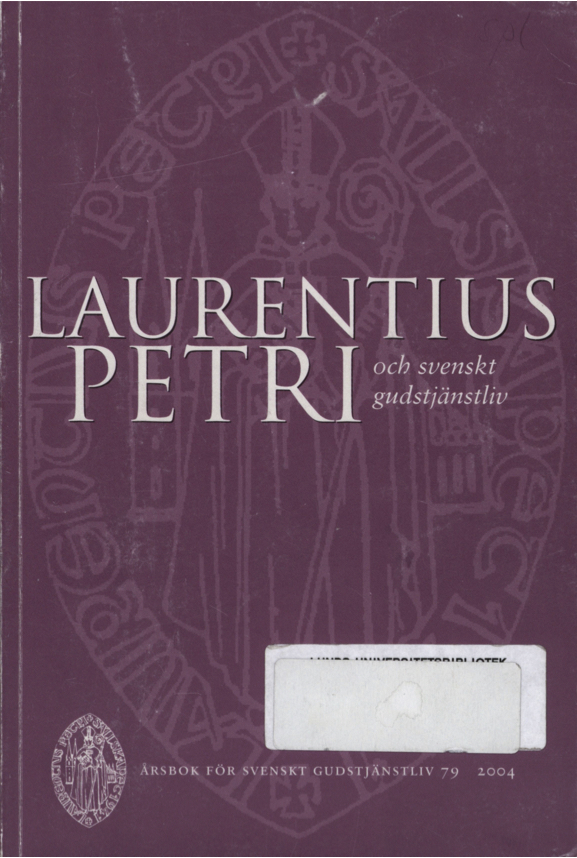Bröderna Petri, Gustav Vasa och gudstjänstreformen
Abstract
Olavus Petri (1493-1552) and his brother Laurentius Petri (1499-1573) were the main Church reformers in Sweden. Both of them had studied under Martin Luther in Wittenberg and become his true adherents. Gustav Eriksson (Vasa), elected king in 1523, became interested in Lutheranism, too, but his motives were mainly political and economical: he strived for absolute power over both State and Church and wanted to incorporate the riches of the Church with the national treasury (which he succeeded to do). He however loved to propagate a picture of himself as the great political and religious Liberator. Sweden (including Finland) and Denmark/Norway had been tied together in the Kalmar union since 1397 (though with several interruptions), but the union was definitely dissolved through Gustav’s successful rebellion against the Danish king Christian II. His annals included an unnuanced charge against all the Catholic bishops for treason against their country. So, during centuries, Patriotism and Lutheranism have been closely associated in Swedish national self-esteem.
For the Petri brothers, a paradoxical situation arose: without the King, probably neither of them would have got the opportunity to work successfully for the evangelical cause, but with the King, they were constantly held within the bounds set by him, and were punished when trying to go their own ways. In 1540, Olavus was even condemned to death for treason, though he was immediately reprieved; the reason lay mainly in his opposition to absolutism and his argumentation for traditional Swedish balance of power between king, council and parliament. Up to that point, Olavus had been active as reformer for nearly 20 years, from 1523 promoted by the King and placed in his vicinity, as the secretary of Stockholm’s city council and as preacher in the foremost city church. He edited collections of sermons, hymn books and liturgical formularies, but also historical and juridical works. He ended up more in the background, but still was accepted by the King as Rector for the most important church in Stockholm.
Laurentius Petri became Sweden’s first evangelical archbishop in 1531, but about 1540 he, too, was shown royal disgrace. The King had employed two advicers from Germany, both wholehearted adherents of absolutism, and had appointed one of them, Georg Normann, superintendent for the whole Swedish church, thereby making the position of the archbishop unclear. The reformation of the divine service had been carried through step by step. The first step was taken in the parliamentary session at Västerås 1527 where it was decided that the Word of God should everywhere in the kingdom be »purely» preached. No change in the liturgy was enjoined, the High Mass continued to be celebrated in latin with all traditional ceremonies, but morning masses in Swedish began to spread starting in Stockholm. In 1540 the King suddenly enacted a decree demanding a »reformation in teaching and ceremonies» and commissioned Normann to supervize the realization of this during visitations in all dioceses. The archbishop, too, became active in realizing the decree. After a violent rebellion in southern Sweden, Normann’s authority was substantially reduced, but the decree for an Evangelical reformation was confirmed by the parliament in Västerås 1544.
A Swedish translation of the eucharistic liturgy had been published in 1531 designed for a »low» mass with little or no chant, but a new edition 1541 gave also directions for a High Mass in Swedish. The Swedish liturgy reform was decidedly conservative: the general progress of the mass was left intact with the exception of the canon missae, the prayers surrounding the words of institution being rejected for dogmatic reasons. The consecrative words were instead joined to the preface and followed by the Sanctus. Unlike the ordinarium missae, the proprium de tempore was never translated. Introit and gradual could still be sung in latin, but they became more and more replaced by Swedish hymns.
After the death of Normann in 1552, the archbishop was the undisputed leader of the church, surviving king Gustav and resisting the Calvinist sympaties of his son Erik XIV. His authority was referred to when the Uppsala council 1593 had to decide about the confessional status of the Swedish church after Johan Ill’s efforts to re-establish the connections with the Catholic Church. In Uppsala, the Augsburg confession from 1530 and Laurentius Petri’s Church Ordinance from 1571 were assumed as confessional documents for the Church of Sweden.
Downloads
Publicerad
Nummer
Sektion
Licens
© författarna, Laurentius Petri Sällskapet för svenskt gudstjänstliv samt Artos & Norma bokförlag. Det är tillåtet att kopiera och använda material ur Svenskt Gudstjänstliv för forskningsändamål om källan anges. För övriga ändamål kontakta respektive artikelförfattare samt förlaget. Särskilda restriktioner kan gälla för bildmaterial.


